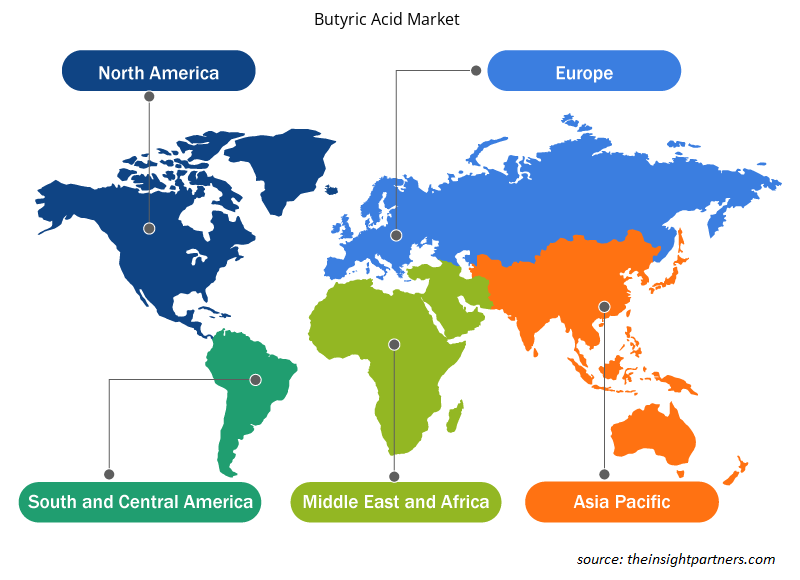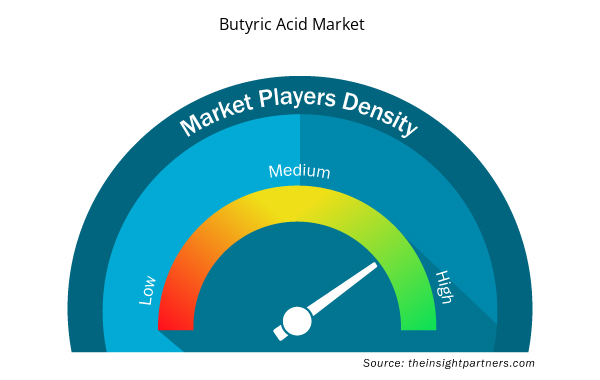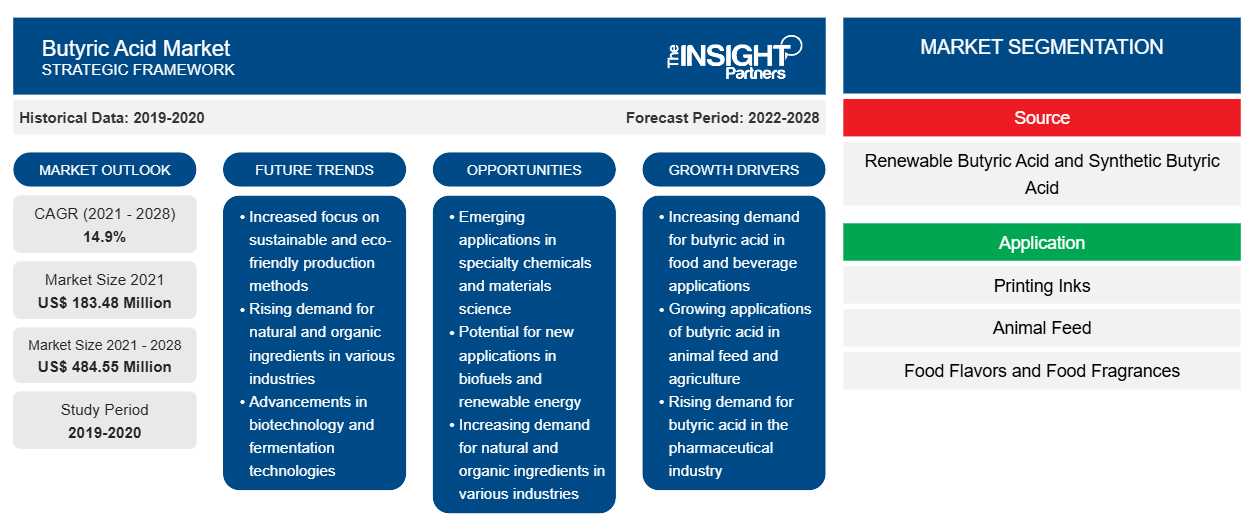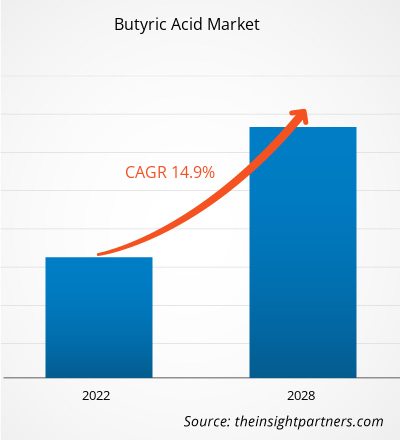2021 年丁酸市场价值为 1.8348 亿美元,预计到 2028 年将达到 4.8455 亿美元;预计 2021 年至 2028 年的复合年增长率为 14.9%。
丁酸是一种无色液体,具有刺激性和难闻的气味。该酸在化学、食品和制药工业中具有各种重要应用。丁酸在制药工业中有许多应用。
2020 年,亚太地区占据了全球市场的最大收入份额。亚太地区畜牧养殖场数量的不断增加,增加了动物饲料的消费,从而促进了丁酸市场的扩张。亚太地区畜牧养殖场的增长可以归因于亚太地区人均收入的提高和消费者健康意识的增强导致对优质肉类产品的需求增加。
定制此报告以满足您的需求
您可以免费定制任何报告,包括本报告的部分内容、国家级分析、Excel 数据包,以及为初创企业和大学提供优惠和折扣
- 获取此报告的关键市场趋势。这个免费样品将包括数据分析,从市场趋势到估计和预测。
COVID-19 疫情对丁酸市场的影响
由于封锁、旅行禁令和企业停业,COVID-19 疫情对各国的经济和行业产生了不利影响。2020 年,由于国家和国际边界关闭导致价值链中断,各行业不得不放慢运营速度,从而限制了对丁酸的需求。COVID-19 疫情导致生产丁酸所需原材料的价格波动。由于食品香精、食品香料和化学中间体等下游行业的需求低迷,全球丁酸消费量下降。由于 COVID-19 疫情导致原材料供应受限和下游行业需求减少,对丁酸市场的增长产生了负面影响。
市场洞察
动物饲料行业需求不断增长
丁酸因其对肠道健康和发育的有益作用而闻名。几十年来,它一直用于动物饲料行业,以确保改善肠道健康和动物性能。此外,随着动物饲料行业转向减少抗生素使用,丁酸已成为肉鸡、蛋鸡、火鸡和猪生产商的首选抗生素替代品。
近年来,随着消费者的饮食偏好转向动物蛋白,各国畜牧业迅速扩张。人口增长、收入激增、生活水平提高和城市化是推动全球肉类需求的关键因素。对肉类产品的需求不断增加,凸显了对动物饲料和饲料添加剂的需求。不同地区对动物饲料产品的需求不断增长,推动了对丁酸的需求,从而促进了丁酸市场的增长。
丁酸是最有益的短链脂肪酸之一,在促进消化健康、控制体重和预防癌症方面发挥着关键作用。全球各国制药业的强劲增长导致丁酸在各种应用中的使用量不断增加。此外,人们对使用丁酸作为生产生物燃料的前体的兴趣也日益浓厚。预计这将在预测期内为丁酸市场的增长提供丰厚的机会。
来源洞察
根据来源,全球丁酸市场已细分为可再生丁酸和合成丁酸。2020 年,合成丁酸部分在全球市场中占有较大份额。合成丁酸部分占主要份额,因为它广泛应用于生产印刷油墨、消毒剂、香精、药品、香水、复活节和食品添加剂等。
全球丁酸市场的一些参与者包括伊士曼化学公司、OQ Chemicals GmbH、东京化成工业株式会社、Perstorp Holding AB、Alfa Aesar、默克集团、Vigon International, LLC.、合肥天健化工有限公司、昆山奥多威尔有限公司和裕丰国际有限公司。丁酸市场的参与者专注于提供高质量的产品以满足客户需求。这些市场参与者高度专注于开发高质量和创新的服务产品以满足客户的要求。
丁酸市场区域洞察
Insight Partners 的分析师已详细解释了预测期内影响丁酸市场的区域趋势和因素。本节还讨论了北美、欧洲、亚太地区、中东和非洲以及南美和中美洲的丁酸市场细分和地理位置。

- 获取丁酸市场的区域特定数据
丁酸市场报告范围
| 报告属性 | 细节 |
|---|---|
| 2021 年市场规模 | 1.8348亿美元 |
| 2028 年市场规模 | 4.8455亿美元 |
| 全球复合年增长率(2021 - 2028) | 14.9% |
| 史料 | 2019-2020 |
| 预测期 | 2022-2028 |
| 涵盖的领域 | 按来源
|
| 覆盖地区和国家 | 北美
|
| 市场领导者和主要公司简介 |
|
丁酸市场参与者密度:了解其对业务动态的影响
丁酸市场正在快速增长,这得益于终端用户需求的不断增长,而这些需求又源于消费者偏好的不断变化、技术进步以及对产品优势的认识不断提高等因素。随着需求的增加,企业正在扩大其产品范围,进行创新以满足消费者的需求,并利用新兴趋势,从而进一步推动市场增长。
市场参与者密度是指在特定市场或行业内运营的企业或公司的分布情况。它表明在给定市场空间中,相对于其规模或总市场价值,有多少竞争对手(市场参与者)存在。
在丁酸市场运营的主要公司有:
- 伊士曼化学公司
- OQ 化学品有限公司
- 东京化成工业株式会社
- 柏斯托控股公司
- 阿法埃莎
免责声明:上面列出的公司没有按照任何特定顺序排列。

- 了解丁酸市场顶级关键参与者概况
报告亮点
- 丁酸市场的渐进式行业趋势可帮助参与者制定有效的长期战略
- 发达市场和发展中市场采用的业务增长战略
- 2019 年至 2028 年丁酸市场定量分析
- 全球 HR-PIB 需求预测
- 波特五力分析说明了行业内买家和供应商的效力
- 了解竞争市场状况的最新发展
- 市场趋势和前景以及推动和抑制丁酸市场增长的因素
- 通过强调支撑商业利益的市场策略来协助决策过程,从而促进市场增长
- 丁酸市场规模在各个节点的大小
- 市场详细概述和细分,以及 HR-PIB 行业动态
- 各地区丁酸市场规模及增长潜力
全球丁酸市场
来源
- 可再生丁酸
- 合成丁酸
应用
- 印刷油墨
- 动物饲料
- 食品香精和食品香料
- 化学中间体
- 制药
- 其他的
公司简介
- 伊士曼化学公司
- OQ 化学品有限公司
- 东京化成工业株式会社
- 柏斯托控股公司
- 阿法埃莎
- 默克集团
- Vigon 国际有限责任公司
- 合肥天杰化工有限公司
- 昆山奥多威尔有限公司
- 昱峰国际有限公司
- 历史分析(2 年)、基准年、预测(7 年)及复合年增长率
- PEST 和 SWOT 分析
- 市场规模价值/数量 - 全球、区域、国家
- 行业和竞争格局
- Excel 数据集



Report Coverage
Revenue forecast, Company Analysis, Industry landscape, Growth factors, and Trends

Segment Covered
This text is related
to segments covered.

Regional Scope
North America, Europe, Asia Pacific, Middle East & Africa, South & Central America

Country Scope
This text is related
to country scope.
常见问题
Growing demand for butyric acid from animal feed sector is one of the major driving factors for the market. Butyric acid is known for its beneficial effects on gut health and development. For decades, it has been in use in the animal feed industry for ensuring improved gut health and animal performance. The use of butyric acid in animal nutrition also helps in improving nutrient absorption.
Asia Pacific (APAC) is anticipated to grow with the fastest CAGR at rate of 15.3% from 2021 to 2028. The growing number of livestock farms in APAC is propelling animal feed consumption levels, subsequently leading to the proliferation of the butyric acid market.
Due to the COVID-19 pandemic, butyric acid manufacturers witnessed a slight disruption in the supply chain of butyric acid during the first two quarters of 2020. However, the supply chain of butyric acid materials has been restored, and production activities have regained normalcy in late 2020. Later, the market was not significantly negatively impacted by the pandemic. Further, with the growing COVID-19 vaccinations and eased in lockdown restrictions, the global economy is resuming, and subsequently, the butyric acid market is regaining its growth.
Based on application, the animal feed segment accounted the largest share of the global butyric acid market. Butyric acid and fatty acids are extensively used in production of poultry and swine feed due to its beneficial properties such as improving digestibility, better colonisation resistance, and improved growth performance among young livestock.
The major players operating in the global butyric acid market are Eastman Chemical Company; OQ Chemicals GmbH; Tokyo Chemical Industry Co., Ltd.; Perstorp Holding AB; Alfa Aesar; MERCK KGaA; Vigon International, LLC.; Hefei TNJ Chemical Industry Co.,Ltd.; KUNSHAN ODOWELL CO.,LTD; and Yufeng International Co.,Ltd.
During the forecast period, Asia Pacific is anticipated to account for the largest share in the global butyric acid market. The region houses few of the fastest developing economies of the world such as China and India and that are the major consumer of the butyric acid. Moreover, in the Asia Pacific region, there is a growing number of livestock farms which is increasing the consumption of animal feed and subsequently proliferating the butyric acid market.
Trends and growth analysis reports related to Chemicals and Materials : READ MORE..
The List of Companies_ Butyric Acid Market
- Eastman Chemical Company
- OQ Chemicals GmbH
- Tokyo Chemical Industry Co., Ltd.
- Perstorp Holding AB
- Alfa Aesar
- MERCK KGaA
- Vigon International, LLC.
- Hefei TNJ Chemical Industry Co.,Ltd.
- KUNSHAN ODOWELL CO.,LTD
- Yufeng International Co.,Ltd
The Insight Partners performs research in 4 major stages: Data Collection & Secondary Research, Primary Research, Data Analysis and Data Triangulation & Final Review.
- Data Collection and Secondary Research:
As a market research and consulting firm operating from a decade, we have published and advised several client across the globe. First step for any study will start with an assessment of currently available data and insights from existing reports. Further, historical and current market information is collected from Investor Presentations, Annual Reports, SEC Filings, etc., and other information related to company’s performance and market positioning are gathered from Paid Databases (Factiva, Hoovers, and Reuters) and various other publications available in public domain.
Several associations trade associates, technical forums, institutes, societies and organization are accessed to gain technical as well as market related insights through their publications such as research papers, blogs and press releases related to the studies are referred to get cues about the market. Further, white papers, journals, magazines, and other news articles published in last 3 years are scrutinized and analyzed to understand the current market trends.
- Primary Research:
The primarily interview analysis comprise of data obtained from industry participants interview and answers to survey questions gathered by in-house primary team.
For primary research, interviews are conducted with industry experts/CEOs/Marketing Managers/VPs/Subject Matter Experts from both demand and supply side to get a 360-degree view of the market. The primary team conducts several interviews based on the complexity of the markets to understand the various market trends and dynamics which makes research more credible and precise.
A typical research interview fulfils the following functions:
- Provides first-hand information on the market size, market trends, growth trends, competitive landscape, and outlook
- Validates and strengthens in-house secondary research findings
- Develops the analysis team’s expertise and market understanding
Primary research involves email interactions and telephone interviews for each market, category, segment, and sub-segment across geographies. The participants who typically take part in such a process include, but are not limited to:
- Industry participants: VPs, business development managers, market intelligence managers and national sales managers
- Outside experts: Valuation experts, research analysts and key opinion leaders specializing in the electronics and semiconductor industry.
Below is the breakup of our primary respondents by company, designation, and region:

Once we receive the confirmation from primary research sources or primary respondents, we finalize the base year market estimation and forecast the data as per the macroeconomic and microeconomic factors assessed during data collection.
- Data Analysis:
Once data is validated through both secondary as well as primary respondents, we finalize the market estimations by hypothesis formulation and factor analysis at regional and country level.
- Macro-Economic Factor Analysis:
We analyse macroeconomic indicators such the gross domestic product (GDP), increase in the demand for goods and services across industries, technological advancement, regional economic growth, governmental policies, the influence of COVID-19, PEST analysis, and other aspects. This analysis aids in setting benchmarks for various nations/regions and approximating market splits. Additionally, the general trend of the aforementioned components aid in determining the market's development possibilities.
- Country Level Data:
Various factors that are especially aligned to the country are taken into account to determine the market size for a certain area and country, including the presence of vendors, such as headquarters and offices, the country's GDP, demand patterns, and industry growth. To comprehend the market dynamics for the nation, a number of growth variables, inhibitors, application areas, and current market trends are researched. The aforementioned elements aid in determining the country's overall market's growth potential.
- Company Profile:
The “Table of Contents” is formulated by listing and analyzing more than 25 - 30 companies operating in the market ecosystem across geographies. However, we profile only 10 companies as a standard practice in our syndicate reports. These 10 companies comprise leading, emerging, and regional players. Nonetheless, our analysis is not restricted to the 10 listed companies, we also analyze other companies present in the market to develop a holistic view and understand the prevailing trends. The “Company Profiles” section in the report covers key facts, business description, products & services, financial information, SWOT analysis, and key developments. The financial information presented is extracted from the annual reports and official documents of the publicly listed companies. Upon collecting the information for the sections of respective companies, we verify them via various primary sources and then compile the data in respective company profiles. The company level information helps us in deriving the base number as well as in forecasting the market size.
- Developing Base Number:
Aggregation of sales statistics (2020-2022) and macro-economic factor, and other secondary and primary research insights are utilized to arrive at base number and related market shares for 2022. The data gaps are identified in this step and relevant market data is analyzed, collected from paid primary interviews or databases. On finalizing the base year market size, forecasts are developed on the basis of macro-economic, industry and market growth factors and company level analysis.
- Data Triangulation and Final Review:
The market findings and base year market size calculations are validated from supply as well as demand side. Demand side validations are based on macro-economic factor analysis and benchmarks for respective regions and countries. In case of supply side validations, revenues of major companies are estimated (in case not available) based on industry benchmark, approximate number of employees, product portfolio, and primary interviews revenues are gathered. Further revenue from target product/service segment is assessed to avoid overshooting of market statistics. In case of heavy deviations between supply and demand side values, all thes steps are repeated to achieve synchronization.
We follow an iterative model, wherein we share our research findings with Subject Matter Experts (SME’s) and Key Opinion Leaders (KOLs) until consensus view of the market is not formulated – this model negates any drastic deviation in the opinions of experts. Only validated and universally acceptable research findings are quoted in our reports.
We have important check points that we use to validate our research findings – which we call – data triangulation, where we validate the information, we generate from secondary sources with primary interviews and then we re-validate with our internal data bases and Subject matter experts. This comprehensive model enables us to deliver high quality, reliable data in shortest possible time.


 获取此报告的免费样本
获取此报告的免费样本